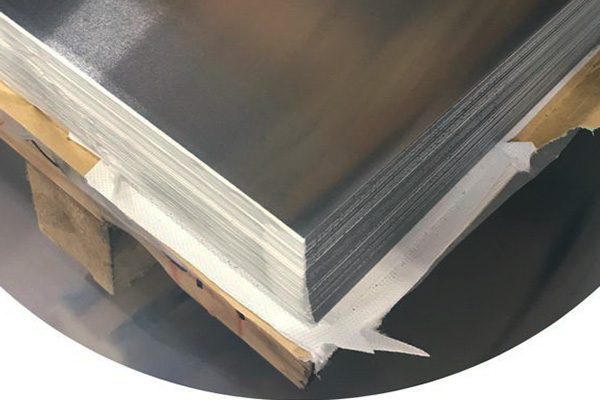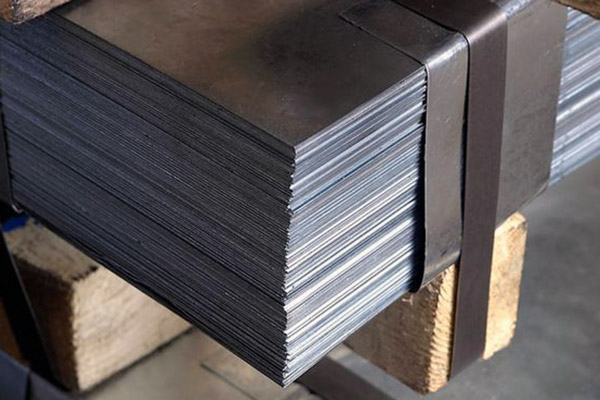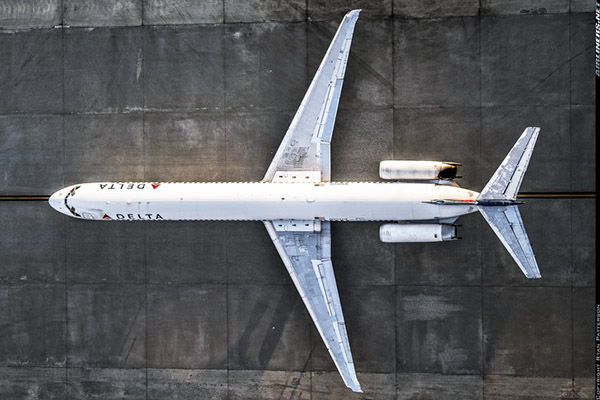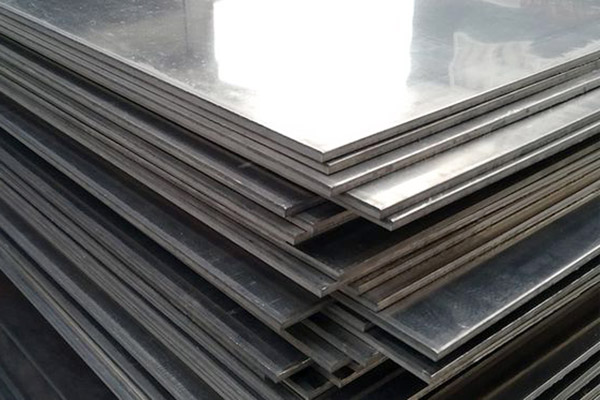2014 Aluminum Plate Sheet
Temper: o/t3/t4/t6 Extrusion/Forging
2014 Aluminum Alloy is a popular aluminum alloy, especially in the aerospace industry, where 2014 T6 Aluminum is often preferred when maximum strength is required.
2014 Aluminum alloy is a typical Al-Cu-Mg-Si alloy that can be deformed and strengthened by heat treatment. Because of its high strength, good corrosion resistance and forgeability, it is widely used in the aerospace field and is usually used. As structural parts such as aircraft hubs.
2014 Aluminum alloys are typically extruded and forged.
- Extrusion is a process in which metal is forced through a die to form complex shapes.
- Forging involves shaping metal through the application of pressure and heat.

From the composition point of view, 2014 aluminum is both a hard aluminum alloy and a wrought aluminum alloy. Compared with 2A50, due to its higher copper content, it has higher strength and better thermal strength, but its plasticity in the hot state is not as good as 2A50. 2014 aluminum has good machinability. Contact welding and spot welding are welding parts that are welded at individual points on the contact surface of the joint.
2014 aluminum has good plasticity and good seam welding performance, but poor arc welding and gas welding performance. 2014 aluminum can be strengthened by heat treatment, has an extrusion effect, has low corrosion resistance, and has a tendency to corrode between inspections during artificial aging.
Aluminum Alloy 2014 Properties
1. High strength 2014 aluminum alloy
Strength: 2014 Aluminum alloy is one of the strongest aluminum alloys available. This high strength makes it ideal for applications where structural integrity and strength are critical, such as aircraft components.
2. 2014 aluminum is easy to process under certain conditions
2014 aluminum is known for being easy to machine in certain states, which is valuable for producing complex parts with precise dimensions. This feature is particularly beneficial in the aerospace industry where complex parts are common.
3. 2014 aluminum alloy has high hardness
2014 aluminum alloy has high hardness, another desirable property for applications where durability and wear resistance are important.
4. 2014 aluminum is not easy to weld
Difficulty Welding: 2014 One of the disadvantages of aluminum is that it is difficult to weld. 2014 aluminum cracks easily during the welding process, making it less suitable for applications that require welding.
5. 2014 aluminum has poor corrosion resistance
A significant weakness of 2014 aluminum alloy is poor corrosion resistance. To solve this problem, it is usually clad with pure aluminum.
Cladding involves applying a layer of pure aluminum to the surface to provide better protection against corrosion.
If unclad and exposed to the elements, 2014 aluminum should be painted as a corrosion protection measure.

2014 Aluminum Typical Temper
2014 aluminum alloy is available in various tempers, each of which represents a different heat treatment and mechanical properties.
- 2014 O Aluminum
- 2014 T3 Aluminum
- 2014 T4 Aluminum
- 2014 T415 Aluminum
- 2014 T6 Aluminum
- 2014 T651 Aluminum
- 2014 T6511 Aluminum
| Material | Temper | Thickness (mm) | Tensile Strength min (N/mm²) | Yield Strength min (N/mm²) | Elongation in 50 mm | ||||
| 0.5 mm | 0.8 mm | 1.3 mm | 2.6 mm | 3.0 mm | |||||
| Alloy 2014 Sheet | T4 Bare | 0.2-6.0 | 400 | 225 | 13 | 14 | 14 | 14 | 14 |
| Alloy 2014 Sheet | T6 Bare | 0.2-6.0 | 440 | 380 | 6 | 6 | 7 | 7 | 8 |
| Alloy 2014 Sheet | T4 Clad | 0.2-1.6 | 385 | 240 | 13 | 14 | 14 | - | - |
| Alloy 2014 Sheet | T4 Clad | 1.6-6.0 | 395 | 245 | - | - | - | 14 | 14 |
| Alloy 2014 Sheet | T6 Clad | 0.2-1.6 | 420 | 345 | 7 | 7 | 8 | - | - |
| Alloy 2014 Sheet | T6 Clad | 1.6-6.0 | 420 | 355 | - | - | - | 9 | 9 |
- 2014-O: This refers to annealed (softened) aluminum, suitable for deep drawing or spinning applications.
- 2014-T4: T4 temper indicates solution heat-treated and naturally aged aluminum. It offers good formability and high strength.
- 2024-T6: T6 temper denotes solution heat-treated and artificially aged aluminum. It's known for its high strength and excellent machinability.
- 2024-T651: This is a stretched aluminum plate, similar to T6 in terms of properties, but with tighter tolerances on flatness and thickness.
- 2014-T3 Clad: Cladding involves bonding a layer of a different metal to the aluminum surface, providing enhanced properties such as corrosion resistance or durability.
- 2014-T4 Clad: Similar to T4 but with the added benefit of cladding, offering improved performance in specific applications.
- 2014-T6 Clad: T6 temper with cladding, combining high strength with additional protective or functional layers.
These grades found applications in various industries including aerospace, automotive, marine, and construction due to their specific properties and performance characteristics.
Typical 2014 Aluminum Alloy Product Forms
- 2014 Aluminum Plate
- 2014 Aluminum Sheet
- 2014 Aluminum Bar
- 2014 Aluminum Wire Rod
- 2014 Aluminum Rod Bar
- 2014 Aluminum Extrusion Profile
- 2014 Aluminum Tube
- 2014 Aluminum Forgings
Aluminium Alloy 2014 Mechanical Properties
Yield Strength of 2014 Aluminum
| Alloy Temper | Tensile Properties | ||
|---|---|---|---|
| 2014 Aluminum | σb/Mpa | σ0.2/M | δ/% |
| 2014-O Aluminum | 185 | 95 | 16 |
| 2014-T4 Aluminum | 425 | 290 | 18 |
| 2014 T415 Aluminum | 425 | 290 | 18 |
| 2014-T6 Aluminum | 485 | 415 | 11 |
| 2014 T651 Aluminum | 485 | 415 | 11 |
Tensile Strength of 2014 Aluminum
The yield strength of 2014-T6 aluminum is typically around 360 MPa (Megapascals). Yield strength is the amount of stress at which a material begins to deform plastically, or in other words, the amount of stress at which a material changes from elastic to plastic deformation.
2014 t6 Aluminum Modulus of Elasticity
The modulus of elasticity for 2014-T6 aluminum is approximately 71 GPa (Gigapascals) or 10.3 x 10^6 psi (pounds per square inch). This property measures the material's stiffness and its ability to return to its original shape after deformation.
2014 Aluminum Sheet Plate Mechanical Properties
- Tensile strength σb (MPa):≥440
- Elongation δ5 (%):≥10
The chemical composition of 2014 aluminum sheet
| Alloy | 2014 | |
| Si | 0.5-1.2 | |
| Fe | 0.7 | |
| Cu | 3.9-5.0 | |
| Mn | 0.4-1.2 | |
| Mg | 0.2-0.8 | |
| Cr | 0.1 | |
| Ni | - | |
| Zn | 0.25 | |
| Ti | 0.15 | |
| Ga | - | |
| V | - | |
| Others | Each | 0.05 |
| Total | 0.15 | |
| Aluminium | min. | Remainder |
What is 2014 Aluminium Alloy Used for?
2014 Aluminum alloy is a valuable material for applications requiring high strength, hardness and workability, but when used in environments where corrosion is a concern, corrosion must be prevented by cladding or painting.
Aerospace Applications: Due to its high strength and excellent machining properties, 2014 aluminum alloy is commonly used in a variety of components in the aerospace industry, including aircraft and spacecraft components.
Various forms of 2014 aluminum are used for different components in the aerospace industry, with each state offering specific properties tailored to the requirements of those components. Here are the different forms and states of 2014 aluminum used in aerospace applications:
1. 2014 O/T4/T651 Aerospace Aluminum Plate
Sheets made from 2014 aluminum in different states are used to manufacture various aerospace components such as aircraft structural parts, wing sections and fuselage panels. Temper selection depends on specific requirements for strength and formability.
2. 2014 T6/H13 Aerospace Aluminum Wire
Aluminum wire is used in electrical and structural applications within aircraft. The T6 temper offers high strength, while the H13 temper is a hot work tool steel used for molds in aerospace manufacturing.

3. 2014 T3/T6511 Aerospace Aluminum Rod Bar
Rods and bars made from 2014 aluminum are used in a variety of aircraft applications, including structural components and other machined parts. The T3 and T6511 tempers offer different combinations of strength and formability.
4. 2014 T6/T651 Aerospace Aluminum Extrusion Profile
Extruded aluminum profiles are widely used in aerospace components such as frames, brackets and structural elements. The T6 and T651 tempers provide high strength and excellent machinability.
5. 2014 T4/T6511 Aerospace Aluminum Tube
Aluminum tubing is commonly used in applications such as hydraulic and fuel lines in the aerospace industry. Temperatures T4 and T6511 offer specific mechanical properties suitable for this type of application.
6. 2014 T3 T4 T6 T651 T6511 Aerospace Aluminum Forgings
Forged components made from 2014 aluminum are used in critical aerospace applications, including engine parts and structural components. Different temper states provide varying degrees of strength and formability to meet the specific requirements of each part.
In the aerospace industry, material selection is critical due to the stringent requirements of flight and the need for lightweight, high-strength materials. 2014 Aluminum alloys are available in different states, providing a variety of options for a variety of components, helping to improve the overall performance and safety of aircraft and spacecraft.
What is the equivalent of 2014 Aluminum?
The aluminum alloy that is comparable or closest to 2014 aluminum is usually 2024 aluminum. The two alloys share many similarities, including high strength and excellent machinability. Here are some key comparisons between 2014 aluminum and 2024 aluminum alloys:
- Strength: Both 2014 aluminum and 2024 aluminum are known for their high strength. However, 2024 aluminum tends to be slightly stronger than 2014 aluminum in various situations.
- Machinability: Both alloys are easy to machine and are often used in applications requiring precision machining. Its excellent machining properties are the main reason for its use in the aerospace industry.
- Copper Content: The primary alloying element of both 2014 and 2024 aluminum is copper, which contributes to its strength. While the copper content of both alloys is similar, 2024 aluminum generally has a slightly higher copper content.
- Uses: Both alloys are used in the aerospace industry for components such as aircraft structural components, wing sections and fuselage panels.
- Corrosion Resistance: Neither alloy is particularly corrosion-resistant, and when used in environments where corrosion is a problem, they are often coated or treated to increase their corrosion resistance.
While 2014 and 2024 aluminum alloys are very similar, the choice between them often depends on specific requirements and availability. In some cases, when slightly higher intensity is required, 2024 may be preferred.
However, both alloys are valuable in applications where high strength and machinability are critical.

Solution Heat-treated 2014 Aluminum Alloy
Solution heat treatment is a commonly used heat treatment process for aluminum alloys (including 2014 aluminum). For 2014 aluminum alloy, solution heat treatment involves the following steps:
- Heating: The first step is to heat the 2014 aluminum alloy to a specific temperature range. This temperature is typically between 890°C and 925°C (1, 634°F and 1, 697°F). The exact temperature depends on the specific material and desired properties.
- Soaking: After the aluminum alloy reaches the specified temperature, it is maintained at that temperature for a certain period of time. This soaking time allows the alloy to reach thermal equilibrium, ensuring that the material reaches a uniform temperature throughout its thickness.
- Quenching: After the soaking period, the aluminum is rapidly cooled by quenching in a suitable quenching medium such as water or air. This rapid cooling "freezes" the aluminum's microstructure into a specific phase.
The main purpose of solution heat treatment is to dissolve and evenly distribute alloying elements, especially copper and magnesium, in the aluminum matrix. This creates a uniform and fine-grained microstructure that enhances the material's mechanical properties, including strength.
For plate and sheet products, solution heat treated 2014 aluminum alloy is usually designated "2014-T4"
For extrusions, forgings, and other forms, it is usually designated "2014-T6."
The "T4" designation indicates that the material has been solution heat treated and naturally aged, while the "T6" designation indicates that the material has been solution heat treated and then artificially aged.
After solution heat treatment, artificial aging is often used to further improve the strength and hardness of the alloy. The exact aging process and timing depend on the required mechanical properties, allowing the material to be tailored to the specific application.
The combination of solution heat treatment and artificial aging allows 2014 aluminum to achieve its required mechanical properties, making it suitable for a variety of high-strength applications, particularly in the aerospace industry.
2014 Aluminum Sheet Plate Stock List
| Product | Temper | Thickness(in) | Thickness(mm) | Size (in) |
| 0.02" 2014 T3 Aluminum Plate | T3 | 0.02" | 0.508 | 48 x 96 in |
| 0.025" 2014 T6 Aluminum Plate | T6 | 0.025" | 0.635 | 36 x 72 in |
| 0.032" 2014 T351 Aluminum Plate | T351 | 0.032" | 0.813 | 24 x 48 in |
| 0.04" 2014 T651 Aluminum Plate | T651 | 0.04" | 1.016 | 48 x 120 in |
| 0.05" 2014 T4 Aluminum Plate | T4 | 0.05" | 1.27 | 36 x 144 in |
| 0.063" 2014 T3511 Aluminum Plate | T3511 | 0.063" | 1.6 | 48 x 96 in |
| 0.08" 2014 T6511 Aluminum Plate | T6511 | 0.08" | 2.032 | 24 x 48 in |
| 0.09" 2014 T7451 Aluminum Plate | T7451 | 0.09" | 2.286 | 48 x 120 in |
| 0.125" 2014 T73511 Aluminum Plate | T73511 | 0.125" | 3.175 | 36 x 72 in |
| 0.16" 2014 T76511 Aluminum Plate | T76511 | 0.16" | 4.064 | 24 x 48 in |
| 0.187" 2014 T73501 Aluminum Plate | T73501 | 0.187" | 4.75 | 48 x 96 in |
| 0.2" 2014 T6 Aluminum Plate | T6 | 0.2" | 5.08 | 36 x 72 in |
| 0.25" 2014 T6 Aluminum Plate | T6 | 0.25" | 6.35 | 24 x 48 in |
| 0.312" 2014 T6 Aluminum Plate | T6 | 0.312" | 7.925 | 48 x 120 in |
| 0.375" 2014 T6 Aluminum Plate | T6 | 0.375" | 9.525 | 36 x 144 in |
| 0.4" 2014 T6 Aluminum Plate | T6 | 0.4" | 10.16 | 24 x 48 in |
| 0.5" 2014 T6 Aluminum Plate | T6 | 0.5" | 12.7 | 48 x 96 in |
| 0.625" 2014 T6 Aluminum Plate | T6 | 0.625" | 15.875 | 36 x 72 in |
| 0.75" 2014 T6 Aluminum Plate | T6 | 0.75" | 19.05 | 24 x 48 in |
| 0.875" 2014 T6 Aluminum Plate | T6 | 0.875" | 22.225 | 48 x 120 in |
| 1" 2014 T6 Aluminum Plate | T6 | 1" | 25.4 | 36 x 144 in |
| 1.125" 2014 T6 Aluminum Plate | T6 | 1.125" | 28.575 | 24 x 48 in |
| 1.25" 2014 T6 Aluminum Plate | T6 | 1.25" | 31.75 | 48 x 96 in |
| 1.5" 2014 T6 Aluminum Plate | T6 | 1.5" | 38.1 | 36 x 72 in |
| 1.75" 2014 T6 Aluminum Plate | T6 | 1.75" | 44.45 | 24 x 48 in |
| 2" 2014 T6 Aluminum Plate | T6 | 2" | 50.8 | 48 x 120 in |
| 2.5" 2014 T6 Aluminum Plate | T6 | 2.5" | 63.5 | 36 x 144 in |
| 3" 2014 T6 Aluminum Plate | T6 | 3" | 76.2 | 24 x 48 in |
| 3.5" 2014 T6 Aluminum Plate | T6 | 3.5" | 88.9 | 48 x 96 in |
| 4" 2014 T6 Aluminum Plate | T6 | 4" | 101.6 | 36 x 72 in |
| 4.5" 2014 T6 Aluminum Plate | T6 | 4.5" | 114.3 | 24 x 48 in |
| 5" 2014 T6 Aluminum Plate | T6 | 5" | 127 | 48 x 120 in |
| 6" 2014 T6 Aluminum Plate | T6 | 6" | 152.4 | 36 x 144 in |
| 7" 2014 T6 Aluminum Plate | T6 | 7" | 177.8 | 24 x 48 in |
| 8" 2014 T6 Aluminum Plate | T6 | 8" | 203.2 | 48 x 96 in |
| 9" 2014 T6 Aluminum Plate | T6 | 9" | 228.6 | 36 x 72 in |
| 10" 2014 T6 Aluminum Plate | T6 | 10" | 254 | 24 x 48 in |
What is the difference between 2014 and 2011 Aluminium?
2011 aluminum vs 2024
2014 aluminum alloy and 2011 aluminum alloy are two distinct materials with some notable differences. While they share the general classification as part of the 2000 series of aluminum alloys, their specific compositions, properties, and applications differ. Here are the key differences between 2014 and 2011 aluminum alloys:
1. Composition
- 2014 Aluminum: The main alloying elements of 2014 aluminum are copper and a small amount of magnesium.
- 2011 Aluminum: 2011 Aluminum is an easily machined alloy whose primary alloying elements are small amounts of bismuth and lead.
2. Strength
- 2014 Aluminum: 2014 is known for its high strength, making it suitable for structural applications, especially in the aerospace industry.
- 2011 Aluminum: 2011 Aluminum is not known for its strength. It is used primarily for its excellent machinability and is not commonly used in high stress or structural applications.
3. Machinability
- 2014 Aluminum: While 2014 aluminum is reasonably machinable, it is not as well-known for this property as 2011 aluminum.
- 2011 Aluminum: 2011 aluminum is known for its exceptional machining properties. It is one of the easiest aluminum alloys to machine, making it a first choice for applications where ease of workability is critical, such as precision components and fasteners.
4. Applications
- 2014 Aluminum: 2014 aluminum is commonly used in the aerospace industry for structural components and parts that require high strength and workability. It can also be used in automotive and other industries that require high-strength aluminum.
- 2011 Aluminum: 2011 aluminum is primarily used for its processability. It is commonly used to make fasteners, screws and other precision components, especially in the automotive and electronics industries.
5. Corrosion Resistance
2014 Aluminum: Both 2014 and 2011 aluminum alloys have poor corrosion resistance. When they are used in corrosive environments, special measures such as cladding or coating are often required.
- 2014 Aluminum is a high-strength alloy primarily used in structural and aerospace applications.
- 2011 Aluminum is known for its excellent machinability and is often used for precision components and fasteners.
The choice between the two alloys depends on the specific requirements of the application, particularly whether strength or ease of processing is the more critical factor.
People also searched for Aluminum Plate
-
2024 Aluminum Plate Sheet
2024 aluminum is a prominent hard aluminum alloy in the aluminum-copper-magnesium series. 2024 aluminum plates are famous for their high strength and excellent fatigue resistance, as well as their ability to be easily processed and welded.
-
2017 Aluminum Plate Sheet
2017 aluminum plate is a heat-treatable forged aluminum product with good strength, ductility and good workability.
-
2219 Aluminum Plate Sheet
2219 aluminum alloy is a high-strength alloy, high temperature resistant and good cutting processing and good mechanical properties. 2219 aluminum plates are in line with AMS QQ-A-250/30. Common TEMPER includes T31, T81, O, etc.
-
2618 Aluminum Plate
2618 aluminum is a high-strength aluminum alloy primarily used in applications requiring excellent mechanical properties, especially in high temperature and high stress environments.
-
7075 Aluminum Plate Sheet
7075 is one of the strongest aluminum alloys available, with an excellent strength to weight ratio. 707 Aluminum Plate is ideal for highly stressed aircraft components.

